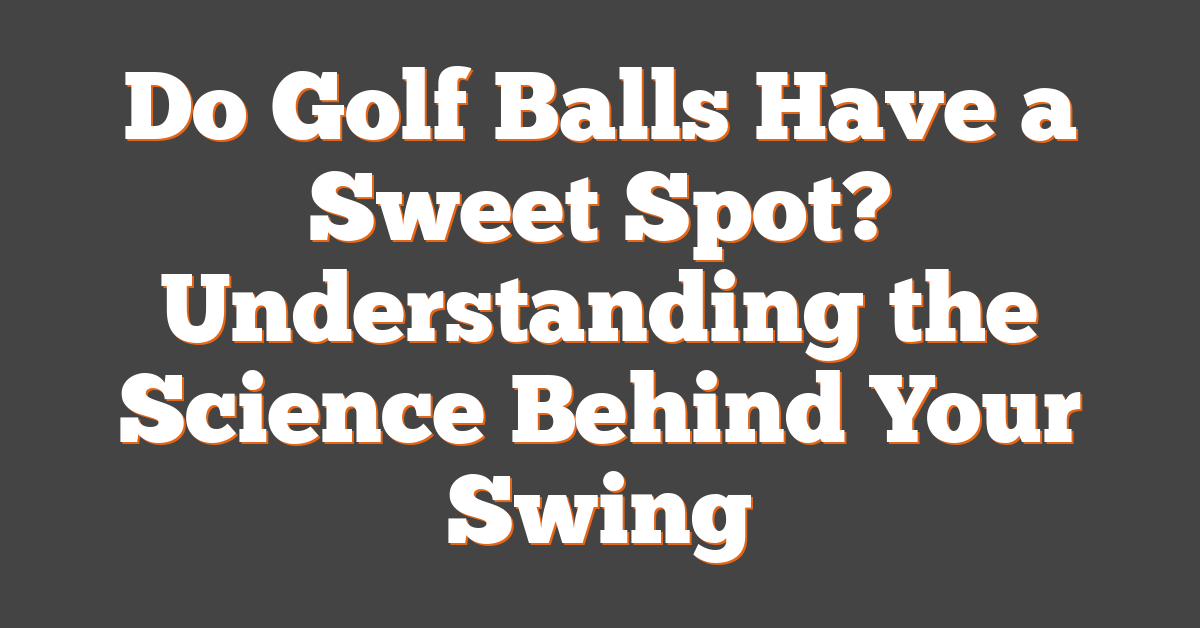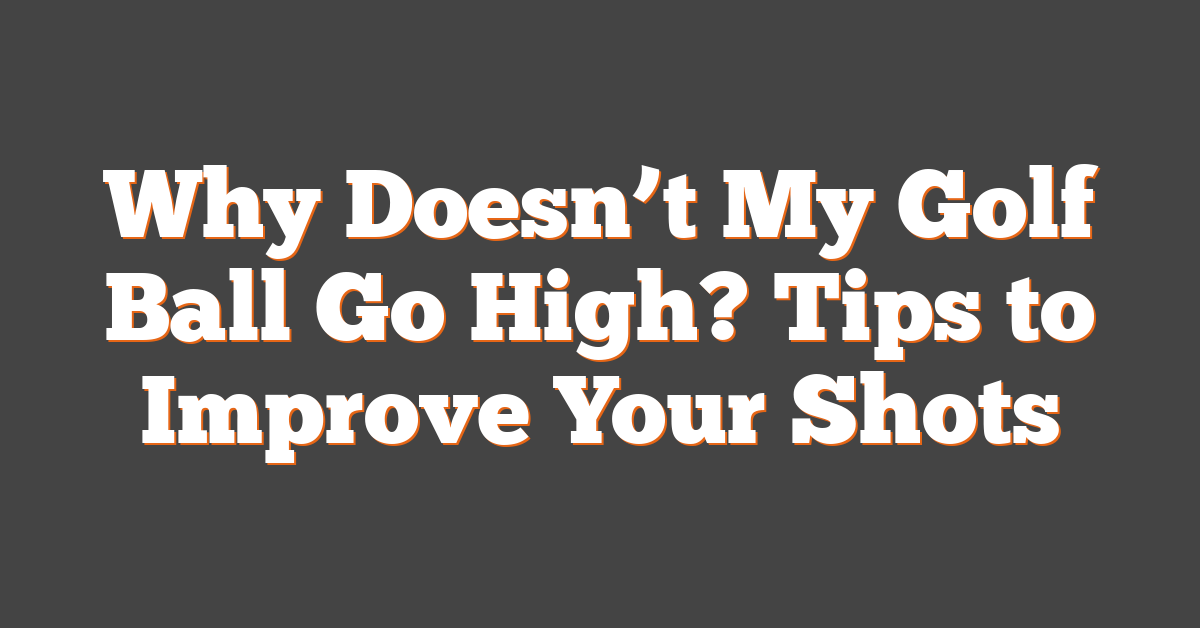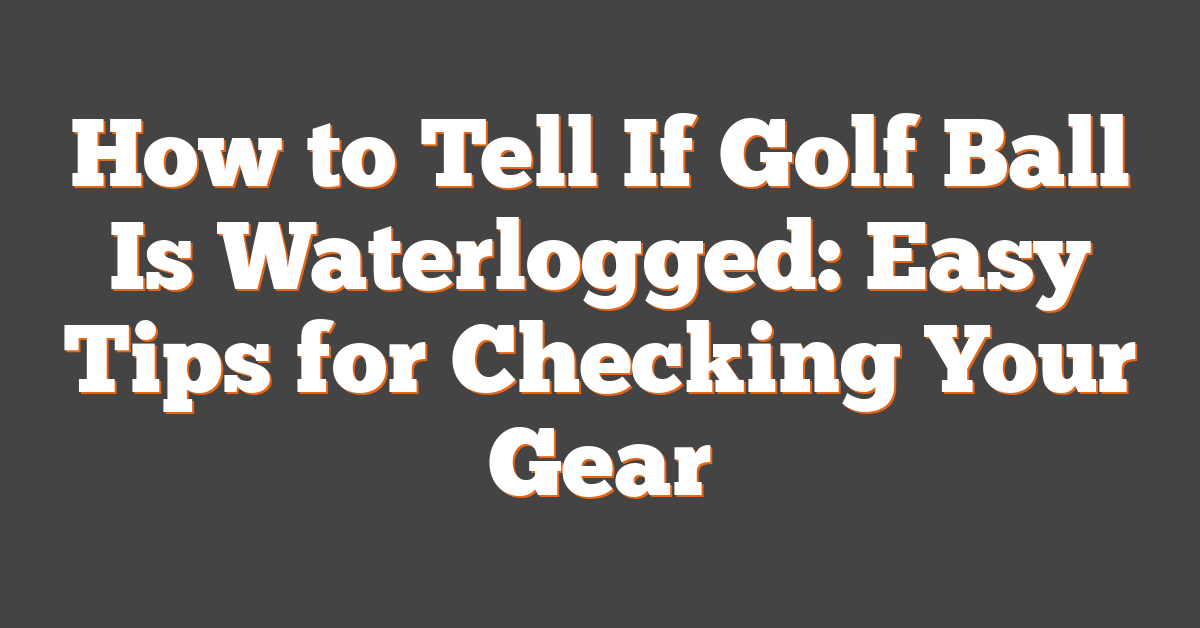When I first learned about the sweet spot of a golf ball, I was surprised at how much it could affect my game. Yes, golf balls do have a sweet spot. This is the optimal area to strike the ball for maximum distance and accuracy. Finding and hitting this sweet spot can lead to better performance on the course.
Understanding the sweet spot is key to improving your golf skills. Different clubs and angles can influence where the sweet spot is located, so it’s important to pay attention. With the right technique and practice, anyone can learn to connect with the sweet spot more consistently.
Exploring this topic will give you insights into how to enhance your swing and the factors that can affect your connection with the ball. So, let’s dive into the details and discover how a little knowledge can make a big difference in my golf game!
Key Takeaways
- Golf balls have a specific sweet spot that enhances performance.
- Factors like club type affect the location of the sweet spot.
- Proper techniques can help improve contact with the sweet spot.
Fundamentals of Golf Balls
When I think about golf balls, I consider their rich history, their unique design, and the materials used to create them. Each aspect contributes to how they perform on the course, especially concerning finding that elusive sweet spot.
History and Evolution of Golf Balls
The history of golf balls is fascinating. They have evolved significantly since the game began in the 15th century. Early balls were made from wood or leather and filled with feathers. These were known as “featheries.”
In the late 1800s, the invention of the gutta-percha ball marked a turning point. This creation was more durable and traveled further. With advancements, by the 20th century, rubber balls became popular, leading to the modern, multi-layered golf balls I use today.
Anatomy of a Golf Ball
A standard golf ball has a core, inner layers, and an outer cover. The core is usually made of rubber and affects distance. Next, the inner layers help control spin and accuracy. Finally, the outer cover protects the ball and affects its feel during contact.
The dimples on the surface are also crucial. They reduce air resistance and help the ball fly straighter. A golf ball typically has around 336 dimples, though this can vary. Each element works together to enhance performance during swings.
Materials and Design
Modern golf balls are primarily made from two types of materials: surlyn and urethane. Surlyn is tough and resistant, ideal for recreational play. On the other hand, urethane is softer, providing more spin and control for serious golfers.
The design has become more advanced. Some balls feature multiple layers, enhancing distance and feel. The dimple pattern also plays a vital role in aerodynamics. Companies continuously test new designs to improve performance, which benefits me as a golfer looking to optimize my game.
Physics of Golf Ball Impact
The physics behind how a golf ball interacts with a club during impact is fascinating. I find the concepts of force, deformation, and energy transfer critical to understanding how to achieve a great shot.
Force and Deformation
When the club strikes the golf ball, a significant force comes into play. This force compresses the ball, causing it to deform upon impact.
- Compression: Different golf balls have varying compression ratings. Low-compression balls are softer and deform more, while high-compression balls are firmer.
- Sweet Spot: Hitting the ball at the sweet spot maximizes the ball’s deformation in the right way, allowing it to spring back effectively.
The degree of deformation affects how energy is transferred from the club to the ball. If I hit the ball off-center, I lose distance due to less effective compression.
Energy Transfer in a Golf Swing
Energy transfer occurs when the kinetic energy from the club is passed to the ball. Proper energy transfer is essential for distance and accuracy.
- Optimal Striking: Hitting the sweet spot means better energy transfer. This can lead to higher ball speeds and longer drives.
- Off-Center Impact: If I strike the ball even slightly off the sweet spot, I can lose about 7% of distance for every half-inch deviation.
Knowing how to achieve the best energy transfer can help me improve my game significantly. Understanding these principles makes a big difference in how I approach each swing.
The Sweet Spot Explained
The sweet spot on a golf ball is crucial for achieving distance and accuracy in my shots. Understanding where to find it and how it affects my performance can greatly improve my game.
Locating the Sweet Spot
Finding the sweet spot on a golf ball is all about knowing its position. This area is usually located near the equator of the ball. It is about 1.5 inches in diameter.
« What is the Best Golf Ball for a Senior Woman: Top Picks for Easy Playing and Distance
How to Tell If Golf Ball Is Waterlogged: Easy Tips for Checking Your Gear »
When I strike the ball at this point, I achieve maximum energy transfer. That means the ball will fly further and straighter.
To locate it, I can look for the dimple pattern on the ball. The smoother sections might indicate where the sweet spot lies. Ensuring my clubface hits this spot is key for better shots.
Impact of Sweet Spot on Performance
Striking the sweet spot enhances my performance on the golf course. When I hit it correctly, the contact results in a more powerful shot. This can lead to a straighter path and a longer distance.
Missing the sweet spot can lead to less control. A shot may hook, slice, or even fall short. The energy transfer is less effective, causing me to lose distance.
Practicing consistently can help me develop a feel for that sweet spot. I can also benefit from feedback on my swings, so I know when I make contact. Finding the sweet spot is like having a secret weapon in my golf game.
Factors Affecting the Sweet Spot
Several key elements play a role in determining the sweet spot on golf balls. Understanding these factors can improve my game and maximize the effectiveness of each shot. Let’s explore how construction and symmetry, along with club quality and type, impact that crucial point of contact.
Golf Ball Construction and Symmetry
The way a golf ball is built significantly affects its sweet spot. Most modern golf balls have multiple layers. These layers impact how energy is transferred during a hit.
- Core Composition: The inner core material can change how the ball compresses. Softer cores offer better feel and distance, impacting where the sweet spot is located.
- Dimple Design: The dimples on a ball help it fly straight. Their placement and depth also influence the ball’s performance, making some balls more forgiving than others.
Symmetry is important, too. A well-balanced ball will have a consistent sweet spot. An unevenly constructed ball may lead to unpredictable shots.
Effect of Club Quality and Type
The quality and type of club I use strongly influence hitting the sweet spot. For example, drivers and irons are designed differently, affecting their sweet spots.
- Club Face Material: High-quality materials provide better feedback and energy transfer. A solid club face can help me consistently hit the sweet spot.
- Club Length and Weight: The length of a club alters my swing dynamics. A club that’s too long or heavy may make it harder to connect with the sweet spot.
Different club types, like wedges versus drivers, also have unique sweet spot locations. Knowing my clubs helps me focus on making better contact.
Maximizing Your Swing
To hit the sweet spot consistently, I focus on specific techniques and practice drills. Understanding these can lead to better contact with the ball, resulting in improved distance and accuracy.
Techniques to Hit the Sweet Spot
One key technique is to ensure my stance is balanced. I like to position my feet shoulder-width apart for stability. This helps me maintain control throughout my swing.
I also pay close attention to my grip. A relaxed grip allows for a smoother swing. I make sure my hands are positioned correctly on the club to promote a fluid motion.
Another important factor is posture. I stand with a slight bend in my knees and tilt forward from my hips. This positioning helps me keep my club on the right path, increasing the chance of hitting the sweet spot.
Practice Drills for Consistency
To improve my consistency, I use specific drills. One of my favorites is the Impact Tape Drill. I apply impact tape to my clubface before hitting balls. The marks left on the tape show me where I make contact with the ball, helping me adjust my swing.
Another effective drill is the Three Tee Drill. I place three tees in a straight line and practice hitting each one. This drill helps me focus on my swing path and encourages hitting the sweet spot.
Lastly, I often use foot spray on the clubface. It provides instant feedback on my contact point. By reviewing where the spray mark is, I can make adjustments to improve my accuracy.
Golf Ball Selection
When selecting the right golf ball, I focus on my playing style and the specific conditions of the courses I frequent. Choosing the right ball can significantly affect my performance and enjoyment of the game.
Choosing the Right Golf Ball for Your Play Style
To pick the best golf ball, I evaluate my typical swing speed and skill level. For slower swing speeds, I choose softer balls that provide better distance. These balls usually have a lower compression rating, which helps in achieving more distance.
For advanced players, a firmer ball may offer greater control and spin. I often prefer multi-layer balls for increased performance, as they enhance spin around the greens. Key features I consider include:
- Compression: Lower for slower swings; higher for faster swings.
- Spin: Softer balls spin more; firmer ones are better for control.
- Feel: I want a ball that feels good off the clubface.
Considering Conditions and Course Types
I adjust my ball choice based on course conditions. For wet or soft courses, I prefer balls that provide more spin and control. These conditions can affect how the ball reacts on approach shots.
In contrast, on dry or hard courses, I choose balls that roll out more. This selection helps maximize distance and prevents loss of shots due to excessive spin.
Weather can also influence my choice. For windy days, I select lower-spinning balls to reduce drag and maintain accuracy. By staying aware of these factors, I can enhance my performance on the course.
Maintenance and Care
Keeping golf balls in good condition is important for optimizing performance and ensuring better contact with the sweet spot. Regular inspection and knowing when to replace them can enhance your game.
Inspecting and Cleaning Golf Balls
I make it a habit to inspect my golf balls before each round. Look for any noticeable damage like cuts, dents, or discoloration. These can affect how the ball performs.
To clean, I use warm water and mild soap. A soft cloth or sponge works well to scrub away dirt and grime. Pay special attention to the dimples since dirt can affect aerodynamics. Rinse the ball thoroughly and dry it with a towel.
I have also found that using a dedicated cleaning solution specifically for golf balls can make a significant difference. It helps remove tough stains without damaging the surface.
When to Replace Golf Balls
Knowing when to replace golf balls is crucial. If I notice consistent issues with distance or accuracy, it might be time for new ones.
Generally, I assess their condition after a few rounds. If a ball has lost its shine or has many scratches, replacing it is best.
Additionally, I consider the number of rounds played. Some players suggest changing them after 30 rounds. Others might wait until the performance changes noticeably.
Trust your instincts and remember, good equipment can boost my confidence on the course.





